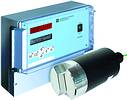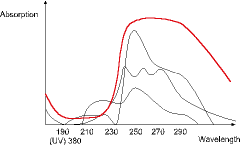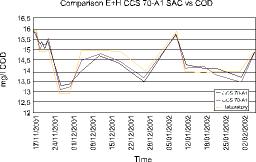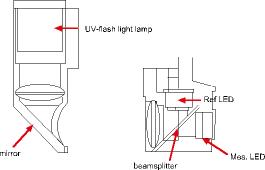

It is becoming increasingly important to take measurements at the right place and the right time. Operators require measuring devices and methods of measurement that require minimum maintenance and do not use chemicals. In addition, these devices are required to be as simple as possible to install and operate. Measurement should be carried out on-site where possible, thereby having response/delay times of only a few minutes in order that the process may be controlled as quickly as possible. This means that load peaks are detected early, and that control measures are introduced in good time.
SAC is the spectral absorption coefficient measured at 254 nm, and its unit is 1/m. When the measured value is given, there should generally also be information about the measurement wavelength. The SAC value is a sum parameter and therefore represents a guide value for organic load in wastewater.
Most devices currently used for determining COD (chemical oxygen demand), BOD (biological oxygen demand.), TOO or DOC (total organic carbon), are expensive. Not only expensive in terms of initial outlay, but also in their maintenance. All methods of measurement are intended to provide a sum parameter based on oxygen. The part ranges captured, however, are not identical, which means that each of these measured values has a different significance. For this reason, every operator chooses a different value from which he believes he can best control his plant, ie the sum parameter he believes to have the greatest significance for his system. Each of these sum parameters has its typical errors, usually within an error range of 5-10%. The SAC value enables the creation of a direct relationship to COD or TOC using correlation in municipal sewage treatment plants. This means that SAC measurement provides a significant sum parameter for dissolved organic contents (Figure 1).

The basic measuring principle
Like nitrate, many organic substances absorb UV light. Specific absorptions may be exploited to identify and measure individual substances. If there is a mixture of many different organic substances, the absorption spectra overlap. This allows one to gain an overview of all the organic substances, (Figure 2).

The measuring principle of the CSS UV sensor is based on the UV light absorption of organic substances. The water sample is exposed to UV light. The transmitted light is deflected to photoreceivers using an optical system of mirrors and lenses and is analysed. A reference measurement compensates for the absorption created by turbidity (Figure 3). Tests at various sewage treatment plants show that there is good correlation in the outflow between COD and SAC and between TOC and SAC.

Benefits of COD or TOC measurement using SAC
The Endress+Hauser CSS 70 SAC probe may be operated by those without technical knowledge. The running costs of the SAC measurement system are also significantly lower than conventional TOC or COD analysers. The system is distinguished by its fast response, since measurement takes place directly in the pool or channel and thus the samples do not need to be prepared, and measurement is therefore without time delay. The measurement process is a direct physical SAC measurement that does not require chemicals or other materials. In addition, the sensor does not require pumps or other moving mechanical components that are subject to wear.

The CSS 70 SAC probe can be used wherever correlation factors need to be determined between TOC (total organic carbon) or COD (chemical oxygen demand) parameters. It is important that there are no significant fluctuations in the composition of the wastewater. Applications in which different types of wastewater are used for different production processes should therefore be avoided, since correlation between TOC and COD is not ideal here. Typical applications are the monitoring of the inflow and outflow of municipal sewage treatment plants.
For more information contact Grant Joyce, Endress + Hauser, 011 262 8000, [email protected], www.za.endress.com
| Tel: | +27 11 262 8000 |
| Email: | [email protected] |
| www: | www.endress.com |
| Articles: | More information and articles about Endress+Hauser South Africa |

© Technews Publishing (Pty) Ltd | All Rights Reserved